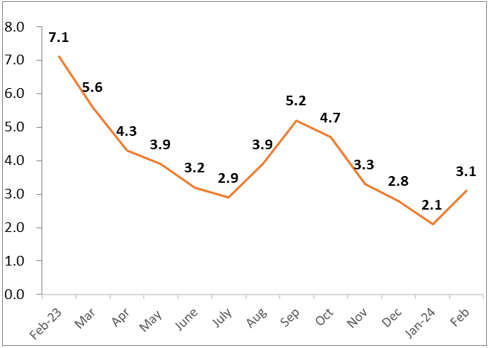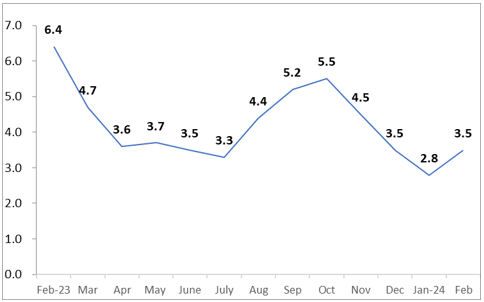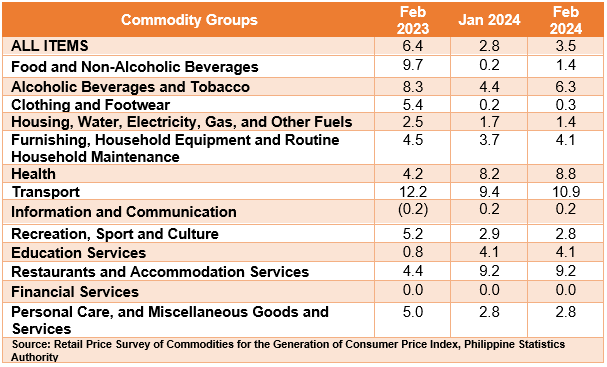Table A. Year-on-Year Inflation Rates, All Items
In percent
(2018=100)

Figure 1. Inflation Rates in CAR, All Items
(2018=100)

Source: Retail Price Survey of Commodities for the Generation of Consumer Price Index, Philippine Statistics Authority
Figure 2. Inflation Rates in Benguet, All Items
(2018=100)

Source: Retail Price Survey of Commodities for the Generation of Consumer Price Index, Philippine Statistics Authority
Table B. Year-on-Year Inflation Rates in Benguet
By Commodity Groups
In percent
(2018=100)

1. Philippines
The Philippines’ headline inflation or overall inflation increased to 3.4 percent in February 2024 from 2.8 percent in January 2024. This brings the national average inflation from January 2024 to February 2024 at 3.1 percent. In February 2023, inflation rate was higher at 8.6 percent.
The uptrend in the overall inflation in February 2024 was primarily influenced by the higher year-on-year increase in the heavily-weighted food and non-alcoholic beverages at 4.6 percent during the month from 3.5 percent in the previous month. The annual increase of transport at 1.2 percent during the month from an annual decline of 0.3 percent in January 2024 also contributed to the uptrend.
Housing, water, electricity, gas and other fuels also contributed to the uptrend as it recorded a faster annual increase of 0.9 percent during the month from 0.7 percent in January 2024. Moreover, higher inflation rate was noted in alcoholic beverages and tobacco at 8.6 percent in February 2024 from 8.4 percent in the previous month.
In contrast, seven commodity groups registered lower inflation rates during the month:
a. Clothing and footwear, 3.6 percent from 3.8 percent;
b. Furnishings, household equipment and routine household maintenance, 3.3 percent from 3.9 percent;
c. Health, 3.0 percent from 3.3 percent;
d. Information and communication, 0.4 percent from 0.5 percent;
e. Recreation, sport and culture, 3.8 percent from 4.0 percent;
f. Restaurants and accommodation services, 5.3 percent from 5.5 percent; and
g. Personal care, and miscellaneous goods and services, 3.8 percent from 4.0 percent.
The indices of education services and financial services retained their previous month’s annual increment of 3.8 percent and annual decrease of 0.6 percent, respectively.
Food Inflation
Food inflation at the national level rose to 4.8 percent in February 2024 from 3.3 percent in January 2024. In February 2023, food inflation was higher at 11.1 percent.
Main Drivers to the Upward Trend of Food Inflation
The acceleration of food inflation in February 2024 was mainly brought about by the slower year-on-year decrease in vegetables, tubers, plantains, cooking bananas and pulses index at 11.0 percent in February 2024 from 20.8 percent annual decline in the previous month. In addition, meat and other parts of slaughtered land animals index recorded a 0.7 percent annual increment during the month from an annual decline of 0.7 percent in January 2024. Cereals and cereal products, which includes rice, corn, flour, bread and other bakery products, pasta products, and other cereals, also contributed to the upward trend of food inflation in the Philippines. It registered a faster annual increment of 17.0 percent during the month from 16.3 percent in the previous month.
2. Cordillera Administrative Region (CAR)
Similar to the national trend, inflation in the region for all income households increased to 3.1 percent in February 2024, from 2.1 percent in January 2024. In February 2023, inflation was higher at 7.1 percent. (Figure 1)
The main driver to the upward trend of the overall inflation for this income group in February 2024 was the higher year-on-year growth in the heavily-weighted food and non-alcoholic beverages at 4.5 percent from 2.5 percent in the previous month. This was followed by transport, which posted a higher annual increase of 3.2 percent during the month from 1.4 percent in January 2024, and health which registered 5.1 percent in February 2024 from 4.6 percent in the previous month.
Higher annual increments were also noted in the indices of the following:
a. Alcoholic beverages and tobacco, 5.5 percent from 4.9 percent;
b. Furnishings, household equipment and routine household maintenance, 3.7 from 3.6 percent;
c. Information and communication, 0.5 percent from 0.4 percent; and
d. Personal care and miscellaneous goods, 2.8 percent from 2.6 percent.
In contrast, lower annual growth rates were noted in the indices of recreation, sport and culture at 2.3 percent in February 2024 from 2.4 percent in the previous month, and restaurants and accommodation services at 5.0 percent during the month from 5.2 percent January 2024.
The indices of the rest of the commodity groups retained their respective previous month’s annual rates.
Food Inflation
Food inflation for all income households at the regional level moved at a faster pace of 4.5 percent in February 2024 from 2.5 percent in the previous month. In February 2023, its annual increase was observed at 10.4 percent.
Main Drivers to the Upward Trend of the Food Inflation
The uptrend in the food inflation was mainly due to the increase in rice at 22.8 percent from 19.6 percent. It was followed by vegetable, tubers, plantains, cooking bananas and pulses at -12.4 percent from -20.3 percent, and meat and other parts of slaughtered land animals at 0.5 percent from -0.1 percent.
3. Benguet
Following the trend of the inflation at the national and regional level, inflation in Benguet increased to 3.5 percent in February 2024, from 2.8 percent in January 2024. In February 2023, inflation was higher at 6.4 percent. (Table B and Figure 2)
The main driver in the uptrend of inflation for all income households in February 2024 was food and non-alcoholic beverages at 1.4 percent, from 0.2 percent in the previous month. This was followed by transport at 10.9 percent from 9.4 percent, and health at 8.8 percent, from the 8.2 percent in the previous month. Moreover, the following also increased during the month:
a. Alcoholic beverages and tobacco, 6.3 percent from 4.4 percent;
b. Clothing and footwear, 0.3 percent from 0.2 percent; and
c. Furnishings, household equipment and routine household maintenance.
On the contrary, decreases were observed in the index of the housing, water, electricity, gas and other fuels at 1.4 percent from 1.7 percent, and recreation, sport and culture at 2.8 percent from 2.9 percent.
Meanwhile, no change recorded for the rest of the commodity groups.
Food Inflation
Food inflation for all income households at the provincial level moved at a faster pace of 1.3 percent in February 2024 from 0.0 percent in the previous month. In February 2023, its annual increase was observed at 10.0 percent.
Main Drivers to the Upward Trend of the Food Inflation
The uptrend in the food inflation was mainly due to the increase in rice at 13.2 percent from 8.8 percent. This was followed by meat and other parts of slaughtered land animals at 1.3 percent from -0.6 percent, and vegetable, tubers, plantains, cooking bananas and pulses at –16.3 percent from -18.4 percent. Increases were also recorded for the following:
a. Corn, -5.3 percent from -10.0 percent;
b. Flour, Bread and Other Bakery Products, Pasta Products, and Other Cereals, 7.3 percent from 6.8 percent;
d. Fish and other seafood, 1.1 percent from -0.2 percent.
On the contrary, decreases were observed in the index of the following:
a. Milk, other dairy products and eggs, 5.3 percent from 9.3 percent;
b. Oils and fats, -8.2 percent from -8.3 percent;
c. Fruits and Nuts, 2.9 percent from 8.0 percent;
d. Sugar, confectionery and desserts, -5.4 percent from -4.8 percent; and
e. Ready-made food and other food products n.e.c., 5.9 percent from 6.4 percent.
Note: CPIs and inflation rates by region, province and selected city are posted at the PSA website (https://openstat.psa.gov.ph/).
(SGD)
IMELDA L. BUYUCCAN
Chief Statistical Specialist
/SMBP

